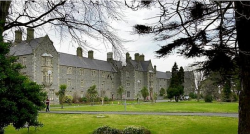Central Mental Hospital
| Central Mental Hospital | |
|---|---|
 | |
| Established | 1850 |
| Opened | 1863 |
| Demolished | 2011 |
| Current Status | Demolished |
| Building Style | Echelon Plan |
| Location | Dublin, IRE |
| Alternate Names |
|
History
The Central Mental Hospital was established in 1850 as a result of recommendations of a parliamentary committee set up in 1843 under Sir Edward Sugden, the then Lord Chancellor of Ireland. The hospital was built on a thirty-four acre site, four miles from Dublin city centre. It was located on a large parkland site because the Victorians realised that people who were seriously mentally ill needed such space and seclusion in order for their condition to improve.
At that time, and following much discussion, it was decided not to co-locate the hospital with a prison, in recognition of the distinction between illness and criminality.1 It is ironic that the Victorians could make such an enlightened decision when, one hundred and fifty years later, modern Irish politicians can decide to co-locate the proposed new hospital with new prison facilities.
The Central Mental Hospital was the first secure hospital in Europe and provided care and treatment for mentally disordered offenders for the entire thirty-two counties up until partition in 1922. It has always been administered by the health authorities.
The hospital provides treatment in conditions of high, medium and low security. Patients come from either the prisons, the courts (either having been referred for assessment or having been found unfit to be tried or not guilty by reason of insanity) or from local psychiatric hospitals. Intensive psychiatric treatment and rehabilitation are provided in a structured therapeutic environment by five consultant-led multidisciplinary teams. The hospital is fully accredited for training purposes by the Royal College of Psychiatrists. It functions very much as a hospital which provides asylum for its patients, many of whom, for one reason or another, have lost contact with their local psychiatric services. Today, the Central Mental Hospital accommodates eighty-two patients, although there is need for a facility able to provide for a much larger number.